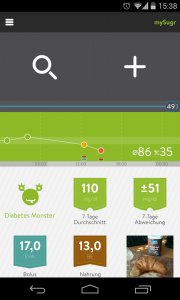Ten years ago, I returned from my student exchange year in Texas. When I got out of the plane in Vienna, I had lost a lot of weight compared to the time I boarded my US-bound plane a year earlier (this is very unusual for exchange students – especially those in the USA). Immediately after my arrival, my family and I went on a two-week holiday in southern France. There, I drank up to nine liters of water or juice a day and went to the bathroom accordingly often. I ate loads of food but still lost weight. I was tired, quiet and glum. Reading books was hard because my eyesight was strangely distorted.
After our return home, we called my uncle, a doctor. He told us to go to the hospital immediately.

Clay shooting a few days before my return to Austria. I was really skinny; fortunately the recoil still did not knock me over.
Diagnosis
Exactly ten years ago, I was diagnosed with Diabetes mellitus type 1 (DM1). This incurable autoimmune disease causes the destruction of the pancreas’ beta cells that produce the hormone insulin. The body needs insulin to move sugar from the bloodstream (its gets there via the digestive system) to the cells that need it (chiefly the central nervous system, but practically all other cells as well). When the body does not get the sugar it needs, it starts to break down fat for nutrients. This is why I lost weight. The breakdown of fat has the unfortunate side effect of polluting the bloodstream with ketone bodies. The body tries to wash them out and tells you to drink lots so you can pee the ketones out. This does not really work, however, and eventually, untreated DM1 leads to ketoacidosis and death. Fortunately, Frederick Banting and Charles Best of the University of Toronto discovered the breakthrough that would save lives including my own: Insulin as medication.
Reactions
I received my first dose of insulin within a few hours of my diagnosis. A dramatic demonstration of this medicine’s effect comes from its earliest history, in 1922:

Frederick Banting (right) and Charles Best (left) ca. 1924. They were awarded the Nobel Prize in Physiology or Medicine in 1923 for the discovery of insulin.
Children dying from diabetic ketoacidosis were kept in large wards, often with 50 or more patients in a ward, mostly comatose. Grieving family members were often in attendance, awaiting the inevitable death. Banting, Best, and Collip went from bed to bed, injecting an entire ward with the new purified insulin extract. Before they had reached the last dying child, the first few were awakening from their coma, to the joyous exclamations of their families.
– Wikipedia: Insulin
“Joyous exclamations” were, naturally, not my family’s first reaction to my diagnosis. I vividly remember my father, who accompanied me to the hospital. After I was diagnosed, put on a bed and hooked up to an intravenous saline drip, he started crying. He felt immensely sad for me and worried. However, as is his nature, his spirits soon lifted (helped, in particular, by the helpful and sympathetic training and support given by the hospital staff). He has been, and still is, one of the most important people in my life with DM1 (and my life in general).
Treatment
My best friend visited me at the hospital on the evening of my diagnosis; many more friends followed in the days after. Of course, my family was there for me as well. After 24 hours in the hospital, my mother noted that I looked a lot better than in the weeks before. I was well cared for by an ambitious doctor and helpful, understanding nurses. In the first few days, I received insulin injections from the nurses, but I quickly switched to self-administering my insulin. After a week, I could leave the hospital. Only a few weeks later, I switched to a flexible insulin therapy method (variously known as flexible insulin therapy, carb counting, Dose Adjustment For Normal Eating or base-bolus therapy). I have since followed this with great success. My HbA1c (a long-term measure of blood sugar) has always been excellent and I have never had hypoglycemia (low blood sugar) to the point where I required assistance. When I was admitted to the hospital, my blood sugar was 53.39 mmol/l (961 mg/dl) and the doctor on duty was surprised that I was still conscious.
Changes
From the first day I have been very diligent with my self-care. I monitor myself very closely, mostly eat OK and exercise reasonably well. Of course I could do better, but at least my doctors think of me as a great patient. 😉 Flexible insulin therapy gives me a lot of freedom (when, what and how much to eat), and it is hard to imagine life without it.

mySugr Companion, which serves as my diabetes logbook and analytic helper.
One area where I was always lacking was logging. I used a glucometer where I could save all essential data (blood sugar, amount of food and insulin), but it was hard to pierce it together into any coherent, easily understood analysis from that device, with few paper logs and no practical way to export it to a computer. Last year, I became an alpha tester for the Android version of the mySugr Companion app. I now log everything DM1-related with this handy app. Preparing for a visit to my doctor means printing out the PDFs prepared by the app, which enable terrific insight on a simple sheet. At my last checkup, my doctor and I could work out a lot of very useful information and recommendations from it.
Outlook
As mentioned, DM1 cannot be cured. I will spend my whole life with the disease, and my life will – statistically speaking – be shortened by it. My plan, however, is to beat the odds and to continue being awesome.
DM1 (as well as DM2, which is significantly more prevalent) is an area of intensive scientific study and financial promise. Current research focuses both on more or less permanent cures (for example through stem cell or gene therapy as well as transplants), better insulin variants (that would allow for fewer injections, for example) and easier monitoring, logging and self-care (this results in things like the mySugr Companion mentioned above). Throughout my life with DM1, I have already benefited from the constant progress made in this area. Undoubtedly, I will continue to greatly benefit from it.
